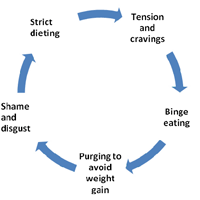By: Nikki Nies
Bulimia nervosa can be a serious, life threatening condition that consists of a cycle of bingeing and compensatory behaviors, such as self induced vomiting, taking laxatives, going on crash diets, exercising and/or fasting to overturn the effect of bingeing. There is a constant battle between wanting to remain slim and a certain weight and not being able to say not to foods. This disorder is often called “bingeing and purging” technique to alleviate calories consumed.
Quick Test:
- Are you obsessed with your body and your weight?
- Does food and dieting dominate your life?
- Are you afraid that when you start eating, you won’t be able to stop?
- Do you ever eat until you feel sick?
- Do you feel guilty, ashamed, or depressed after you eat?
- Do you vomit or take laxatives to control your weight?
The more times you answered “yes” to the above questions, the more likely you may have bulimic like behaviors. 
I don’t know any one who hasn’t succumbed to society’s definition of what’s beautiful. Unfortunately, bulimia often results in the desire to lose weight and dieting. However, the stricter the dietary restrictions are, the more likely one will become preoccupied and/or obsessed with food.
Signs and Symptoms Bingeing and Purging:
- Lack of self-control when eating: eating even when full to the point of discomfort and pain
- Extreme concern of body shape and weight
- Withdrawal from usual activities and friends
- Continued exercise despite injuries
- Dry or loose skin
- Creation of schedules and rituals to make time for bingeing and purging
- Using laxatives, diuretics or enemas
- Eating unusually large amounts of food with no obvious change in weight
- Alternating between overeating and fasting: has the “all or nothing” mentality
- Secrecy regarding eating: goes out alone on food runs; eats in the kitchen; is always “full”
- Uses saunas to “sweat out” water weight
- Goes to the bathroom after meals: may run the water to disguise the sound of vomiting
- Smells of vomit: the bathroom or the person may smell like vomit; may try to cover up the odor with perfume, air freshener, mouthwash
- Calluses or scars on the knuckles or hands: from the induced vomiting
- Discolored teeth (i.e. yellow, ragged or clear) from exposure to stomach acid when vomiting
- Weight fluctuations: due to bingeing and purging
- “Chipmunk” cheeks
Impact of Bulimia on Person:
- Dehydration due to vomiting
- Electrolyte imbalance due to vomiting or use of diuretics or laxatives
- Lethargy
- Cloudy thinking
- Kidney failure with low potassium levels
- Ab Pain
- Bloating
- Swelling of extremities
- Broken blood vessels in the eyes
- Chronic sore throat/hoarseness
- Swollen cheeks and salivary glands
- Weakness and dizziness
- Mouth sores and tooth decay
- Acid reflux
- Ruptured stomach and/or esophagus
- Amenorrhea
- Chronic constipation
Treatment:
There’s no quick fix treatment to help those with bulimia. It’s often a heavily layered disorder that requires a team of professionals to help those battling with bulimia. With the many causes of eating disorders, such as major life changes, history of trauma or abuse, poor self esteem and body image, treatment will be an ongoing process.
Bulimia impacts 1-2% of adolescent and adult women, however, there is help waiting to provide the necessary guidance needed.
Sources: http://www.nationaleatingdisorders.org/bulimia-nervosa
http://www.webmd.com/mental-health/bulimia-nervosa/bulimia-nervosa-symptoms
http://www.helpguide.org/mental/bulimia_signs_symptoms_causes_treatment.htm

